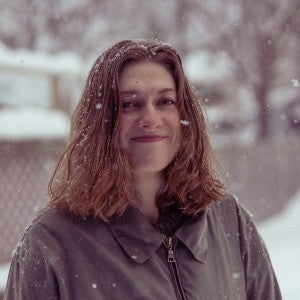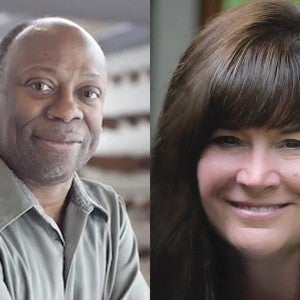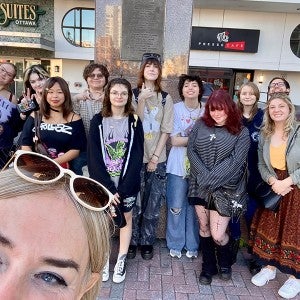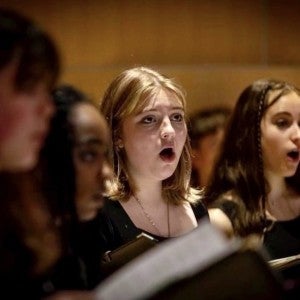The art of problem solving
Four Interlochen alumni share how their arts backgrounds inform their work in the sciences.
In times of crisis, many cling to science for the concrete solutions it offers to our problems. There is a certain comfort in the regimented nature of science: Its laws, its data tables, its tried-and-true experimental methods.
But there are limits to science. Occasionally, we face a crisis that defies the scientific method, an issue whose solution will not be observable, measurable, and repeatable.
In these moments, we look to our creative problem-solvers, those who search for outside-the-box for answers to life’s most challenging riddles. Many of these individuals are artists-turned-scientists who cut their teeth in creative pursuits before pursuing a life of theories and equations. We caught up with four Arts Camp and Arts Academy alumni to learn how their creative pasts inform their scientific careers.
Developing discipline and focus
For all four alumni, one of the most important lessons their musical training taught them was discipline.
“The self-discipline that I learned by being involved with the arts at Interlochen definitely helped me develop patience and discipline in solving scientific problems,” said Holly Gilbert (IAA 86-88), a NASA heliophysicist and Interlochen Arts Academy cello alumna.
Aaron Parness (IAC 91-93), an Interlochen Arts Camp violin alumnus and principal research scientist on Amazon’s robotics and AI team, agrees. “The arts improved my ability to focus deeply for long periods of time—a skill I honed during practice sessions,” he said. “One of my greatest assets at work has been my ability to concentrate intensely on a complex task. Reaching that state of 'flow' is something I probably first experienced playing the violin.”
For independent public health and development consultant Timothy Thomas (IAA 76-78), a lesson from an arts instructor continues to guide his work in the scientific sphere. “I met an acting teacher who said, ‘be ruthless in your pursuit of the specific,’” Thomas said. “That has always governed how I work: doggedly pursuing the specific, trying to find what’s real and authentic in any piece I create. That commitment to specificity is important for anybody in any profession—whether they’re a surgeon, a stockbroker, or a farmer.”
Learning to play with others
While musical training often takes place in the privacy of a practice room, orchestras and chamber ensembles provide opportunities to learn the importance of collaboration.
“Playing the cello and piano taught me how to work together on a team, like in chamber music,” said Joyce Wong (IAC/NMC 78-81), a professor of biomedical engineering at Boston University. “I learned how important it is to trust your partners and pull your weight in a project.”
For Parness, the orchestra—with different players performing different parts—served as a model for how individuals with diverse skills can collaborate to solve one problem. “Playing in an orchestra provided a fertile learning opportunity for teamwork and coordinated effort,” Parness said. “All of my projects today rely on teams of scientists and engineers that bring different skills to the problem.”
Disrupting the scientific method
Science is by nature analytical. However, all have found ways to inject their creativity into the sciences.
“Being embedded with incredibly creative people at Interlochen has given me a unique perspective in attacking science,” Gilbert said. “I think I learned early on that innovation and creativity are intimately related, and it's incredibly important to leverage innovation at a place like NASA.”
Gilbert’s problem-solving method echoes the musician’s task: Applying privately honed techniques in an ensemble setting. “I first approach problems from all angles, making sure I understand the core of the problem,” she said. “Then I consult with others, preferably a diverse group of scientists, to develop potential solutions. Often, one solution is not obvious—nor is it the only approach.”
Wong, too, recognizes the parallels between practice and science. “I like to break the problem up into smaller pieces, like I would if I were learning a difficult musical piece,” she said.
Creativity is at the core of Parness’s approach to problem-solving, a technique known as iterative design. “When confronted with a difficult problem, I try to brainstorm as many possible solutions as I can before I start to pass any judgement,” he said. “In this divergent stage of the process, it's about being creative and generating outside-the-box ideas. After my team has exhausted ourselves, only then do we start to prioritize and rank what we want to prototype.”
Thomas, who frequently collaborates with scientists, understands the importance of his unique voice in the search for solutions. “Scientists see things in black-and-white, in terms of ‘it works’ or ‘it doesn’t’,” Thomas said. “What I add to the conversation is a reminder that there are many ways to look at a problem. There are factors that influence the problem that we may not know, and we have to explore the unknowns and be honest in our commitment to see all points of view and facets of the problem. A creative mind brings that into a question that would otherwise be solved in a binary way.”
Embracing a growth mindset
In a swiftly changing professional field, Parness leans on the growth mindset that his musical training helped develop. “Music provided an opportunity to internalize the process of improving with practice,” he said. “Today, I'm not afraid to dive into a subject where I'm not an expert, like machine learning and artificial intelligence in the past year, because I know that I can learn and get better over time. Being fearful of taking on new challenges is something I've seen hold back many of my colleagues.”
Maintaining balance
Music and art remain a durable part of all their lives and an important counterpoint—or enhancement—to their scientific careers.
“I listen to music while grant writing, namely Mozart’s Requiem,” Wong said. “I also enjoy going to concerts. I would love to play chamber music again.”
Gilbert recently picked up the cello again after more than 30 years away from the instrument. “It definitely provides a dimension to my life that is hard to get from other things,” she said. “My daughters are also musical, so we have music in the house often. Music really is fundamental to feeding my soul and making my life full.”
Parness, too, enjoys sharing the arts with those closest to him. “My wife, Alma, and I subscribed to the LA Philharmonic for many years, and we regularly attend the theatre with my sister Rachel,” he said. “Recently, it's been incredibly fun introducing our two daughters to music, dance, and visual art. I'm looking forward to lots of daddy-daughter duets and trios!”
Thomas remains perhaps the most involved in the arts: When not consulting on public health, he performs semi-professionally as a classical singer, takes acting classes, teaches private voice lessons, and is a member of the board of several New York City arts organizations.
“I’ve never really left the arts,” he said. “ It’s always been an integral part of my life. I just stopped trying to make my living in it.”









